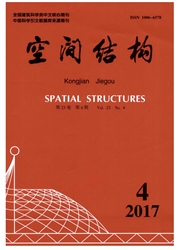

 中文摘要:
中文摘要:
工程实践中焊接空心球节点受压极限承载力的试验都是按照JGJ11-2009中的相关规定进行的,要求试验时需要适当增加钢管壁厚,但是对于需要加厚到什么程度,并没有明确的说明.有限元计算分析表明,按照JGJ11-2009要求设计的节点在加载时多是钢管先于空心球屈服而导致不能继续加载,空心球并未真正的破坏,所得的承载能力并非节点真实的极限承载能力.利用ANSYS有限元程序对外径800mm的5组131个空心球节点进行单向受压分析,得到了不同尺寸的钢管与空心球匹配关系下,球节点的破坏模式及相应的节点极限承载能力,并对外径800mm的空心球进行受压试验时钢管壁厚需要的增加量提出了参考值.
 英文摘要:
英文摘要:
In the engineering practice,test of ultimate bearing capacity of welded hollow spherical joint is generally conducted according to the demands of JG11-2009[8],which regulated wall-thickness of steel pipe should be increased before the test.But it didn't clearly illustrate how to realize the increase.ANSYS analysis of models designed according to the JG11-2009 [8] shows for most time steel pipes yield before the spherical joint under press.So the ultimate bearing capacity obtained maybe not the true value of the joints.Through the analysis of 131 joints with different parameters,the failure model and corresponding ultimate bearing capacity were obtained.And a necessary increase of wall-thickness of steel pipe which matches joints with radius of 800mm is suggested.
 同期刊论文项目
同期刊论文项目
 同项目期刊论文
同项目期刊论文
 期刊信息
期刊信息
